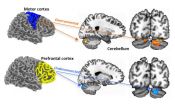Alternating antibiotics render resistant bacteria beatable
2015-04-08
(Press-News.org) Given the alarming rise of antibiotic-resistant bacteria, and the long lead-in time for developing novel drugs, the discovery of new ways to use the antibiotics already available and approved for use in humans is paramount. It is generally believed that to eliminate a bacterial infection before the onset of drug resistance one must treat with large doses of antibiotics, but recent research has indicated that this type of treatment might actually be driving the emergence of drug-resistant pathogens.
New research publishing April 8th in the Open Access journal PLOS Biology from Ayari Fuentes-Hernandez, Jessica Plucain, Robert Beardmore and colleagues, demonstrates that drug treatments with two antibiotics can be designed to kill bacteria at dosages that - when the drugs are administered alone or in combination - cause rapid development of drug resistance and sustained bacterial growth. These treatments, called "sequential treatments," use alternating low doses of two antibiotics. The researchers used a test-tube model of a bacterial infection to show that, even in bacteria that contain drug resistance genes, sequential treatments could kill the bacteria, while high doses of single drugs or mixtures of two drugs failed to do so.
"Our study finds a complex relationship between dose, bacterial population densities and drug resistance," says the paper's lead author Dr. Robert Beardmore (whose research group is based at the University of Exeter). "As we demonstrate, it is possible to reduce bacterial load to zero at dosages that are usually said to be sub lethal and, therefore, are assumed to select for increased drug resistance."
Interestingly, the researchers found by comparing the genetic changes occurring during single-drug versus sequential treatments that both treatments promoted the emergence of known drug-resistance mutations.
Therefore, the success of sequential treatments was not through averting or suppressing drug resistance. Instead, they hypothesize that the evolutionary response to sequential drug treatment leads to a state where one drug sensitizes the bacteria to the second drug.
"Research has concentrated for decades on synergistic drug cocktails. We believe 'sequential synergies' might be just as potent if we look for them, this research will therefore be of interest to the pharma and dwindling antibiotic discovery communities," says Dr. Beardmore. While bacteria are masters at adapting to antibiotic challenge, this research suggests that there is a way to use this adaptation against them. The fluctuating environments created by well-designed sequential treatments can sensitize bacteria and render them susceptible to concentrations of antibiotics that would normally induce drug resistance and continued existence.
Unfortunately, not all sequential treatments are equally efficacious. Extensive further work will be needed before sequential treatments make it in to the clinic, but this study demonstrates that they can be effective even when using drug doses below their maximal potency. According to Dr. Beardmore, "One outcome of this highly surprising result will be to set in motion a series of studies to determine ways of using antibiotics not only in combination, but sequentially and with the potential for lower dosages than is currently thought possible."
INFORMATION:
Contact:
Dr Robert Beardmore
Professor of Mathematical Biosciences
Biosciences (Geoffrey Pope)
University of Exeter
Stocker Road
Exeter
EX4 4QD, UK
+44 (0)1392 725 839
R.E.Beardmore@exeter.ac.uk
Citation:
Fuentes-Hernandez A, Plucain J, Gori F, Pena-Miller R, Reding C, Jansen G, et al. (2015) Using a Sequential Regimen to Eliminate Bacteria at Sublethal Antibiotic Dosages. PLoS Biol 13(4): e1002104. doi:10.1371/journal.pbio.1002104
Funding:
RB was funded by grants EP/I00503X/1 and EP/I018263/1 from the UK Engineering and Physical Sciences Research Council. See: http://gow.epsrc.ac.uk/NGBOViewPerson.aspx?PersonId=67077. The funders had no role in study design, data collection and analysis, decision to publish, or preparation of the manuscript.
Competing Interests:
The authors have declared that no competing interests exist.
http://journals.plos.org/plosbiology/article?id=10.1371/journal.pbio.1002104 END
ELSE PRESS RELEASES FROM THIS DATE:
2015-04-08
Pioneering new research has unlocked a new technique to help combat the rise of antibiotic-resistant bacteria, that cause debilitating and often life-threatening human illness.
Researchers from the University of Exeter has shown that the use of 'sequential treatments' - using alternating doses of antibiotics - might offer effective treatment against bacterial infection.
Crucially, the research also demonstrates this technique for administering treatment also reduces the risk of the bacteria becoming resistant to antibiotics, and so maintaining the long-term effectiveness ...
2015-04-08
EVANSTON, Ill. --- A new approach to analyzing baseball-pitching biomechanics may one day give players more personalized feedback and help prevent elbow injuries.
In a computer simulation study of baseball pitching, Northwestern University biomedical engineers found that the strength of the elbow muscles of a baseball pitcher likely play a bigger role in injury risk and prevention than previously thought.
The motion analysis approach currently used in the baseball industry to provide athletes with injury-risk feedback is not sophisticated enough to estimate what an ...
2015-04-08
WELLESLEY, Mass. - A new study by Heather Mattila, a leading honey bee ecologist and Assistant Professor of Biological Sciences at Wellesley College, published on April 8 in PLOS ONE, reveals that inadequate access to pollen during larval development has lifelong consequences for honey bees, leading not only to smaller workers and shorter lifespans, but also to impaired performance and productivity later in life. For the first time, this study demonstrates a crucial link between poor nutrition at a young age, and foraging and waggle dancing, the two most important activities ...
2015-04-08
In early childhood, the neurons inside children's developing brains form connections between various regions of brain "real estate." As described in a paper published last week in the journal Biological Psychiatry, cognitive neuroscientists at San Diego State University found that in children and adolescents with autism spectrum disorder, the connections between the cerebral cortex and the cerebellum appear to be overdeveloped in sensorimotor regions of the brain. This overdevelopment appears to muscle in on brain "real estate" that in typically developing children is more ...
2015-04-08
A single infusion of an experimental anti-HIV antibody called 3BNC117 resulted in significantly decreased HIV levels that persisted for as long as 28 days in HIV-infected individuals, according to Phase 1 clinical trial findings published online today in Nature. Major funding for the research was provided by the Bill and Melinda Gates Foundation, The Rockefeller University, and supported in part by the National Institute of Allergy and Infectious Diseases (NIAID), a component of the NIH. The research was led by long-time NIAID grantee Michel C. Nussenzweig, M.D., Ph.D., ...
2015-04-08
The four collaborating organizations are the American College of Nurse-Midwives; the American College of Obstetricians and Gynecologists; the Association of Women's Health, Obstetric and Neonatal Nurses; and the Society for Maternal-Fetal Medicine. Additionally, these organizations partnered with VitalSmarts, a research and training organization.
The report, "Transforming Communication and Safety Culture in Intrapartum Care: A Multi-organization Blueprint," follows previous research on safety concerns during childbirth and communication among labor and delivery teams. ...
2015-04-08
Washington, DC--Pesticide exposure, not obesity alone, can contribute to increased cardiovascular disease risk and inflammation in premenopausal women, according to a new study published in the Endocrine Society's Journal of Clinical Endocrinology & Metabolism.
The study looked at the effects of exposure to polychlorinated pesticides such as DDT. Although DDT was banned in many countries in the 1970s, it remains widespread in the environment and food supply.
DDT was one of the first recognized endocrine-disrupting chemicals, according to the introductory guide to endocrine-disrupting ...
2015-04-08
A collaboration led by Shigeyuki Yokoyama of RIKEN and Takashi Kadowaki and Toshimasa Yamauchi of the University of Tokyo has used the SPring-8 synchrotron facility in Harima, Japan to elucidate the structure of two receptors of adiponectin, a protein that is associated with obesity and diabetes. The researchers hope that in the future this work, which was published in Nature today, will pave the way toward designing drugs that target these two receptors, AdipoR1 and AdipoR2, to reduce the early mortality associated with diabetes.
Adiponectin, a hormone secreted by fat ...
2015-04-08
In the first results to emerge from HIV patient trials of a new generation of so-called broadly neutralizing antibodies, Rockefeller University researchers have found the experimental therapy can dramatically reduce the amount of virus present in a patient's blood. The work, reported this week in Nature, brings fresh optimism to the field of HIV immunotherapy and suggests new strategies for fighting or even preventing HIV infection.
In a person infected with HIV, there is an ongoing arms race between the virus and the body's immune system. Even as the body produces new ...
2015-04-08
In a feat that would have been unachievable only a few years ago, researchers at UC San Francisco have pulled aside the curtain on a protein informally known as the "wasabi receptor," revealing at near-atomic resolution structures that could be targeted with anti-inflammatory pain drugs.
Officially named TRPA1 (pronounced "trip A1"), the newly visualized protein resides in the cellular membrane of sensory nerve cells. It detects certain chemical agents originating outside our bodies--pungent irritants found in substances ranging from wasabi to tear gas--but is also triggered ...
LAST 30 PRESS RELEASES:
[Press-News.org] Alternating antibiotics render resistant bacteria beatable


